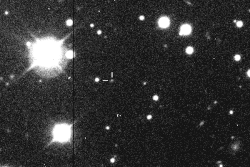Harpalyke (moon)
Harpalyke /hɑːrˈpælɪkiː/, also known as Jupiter XXII, is a retrograde irregular satellite of Jupiter. It was discovered by a team of astronomers from the University of Hawaii led by Scott S. Sheppard in 2000, and given the temporary designation S/2000 J 5.[6][1] In August 2003, the moon was named[7] after Harpalyke, the incestuous daughter of Clymenus, who in some accounts was also a lover of Zeus (Jupiter).
 Harpalyke imaged by the Canada-France-Hawaii Telescope in December 2001 | |
| Discovery [1] | |
|---|---|
| Discovered by | Scott S. Sheppard David C. Jewitt Yanga R. Fernandez Eugene A. Magnier |
| Discovery site | Mauna Kea Observatory |
| Discovery date | 23 November 2000 |
| Designations | |
Designation | Jupiter XXII |
| Pronunciation | /hɑːrˈpælɪkiː/[2] |
Named after | Ἁρπαλύκη Harpălykē |
| S/2000 J 5 | |
| Adjectives | Harpalykean /hɑːrpəlɪˈkiːən/ |
| Orbital characteristics [3] | |
| Epoch 17 December 2020 (JD 2459200.5) | |
| Observation arc | 17.39 yr (6,350 days) |
| 0.1422492 AU (21,280,180 km) | |
| Eccentricity | 0.1602677 |
| –634.19 d | |
| 321.08380° | |
| 0° 34m 3.555s / day | |
| Inclination | 148.29788° (to ecliptic) |
| 92.54746° | |
| 193.28018° | |
| Satellite of | Jupiter |
| Group | Ananke group |
| Physical characteristics[4] | |
Mean diameter | 4 km |
| Albedo | 0.04 (assumed) |
| 22.2[5] | |
| 15.9[3] | |
Harpalyke belongs to the Ananke group, believed to be the remnants of a break-up of a captured heliocentric asteroid.[8][9] It is about 4 kilometres in diameter[10] and appears grey (color index R-V=0.43), similar to C-type asteroids.[11] The satellite orbits Jupiter at an average distance of 21,064,000 km in 624.542 days, at an inclination of 147° to the ecliptic (147° to Jupiter's equator) with an eccentricity of 0.2441.
References
- MPEC 2001-A28: S/2000 J 2, S/2000 J 3, S/2000 J 4, S/2000 J 5, S/2000 J 6 January 5, 2001 (discovery and ephemeris)
- as 'Harpalyce', 'Harpalycus' in Noah Webster (1884) A Practical Dictionary of the English Language
- "M.P.C. 127087" (PDF). Minor Planet Circular. Minor Planet Center. 17 November 2020.
- "Planetary Satellite Physical Parameters". Jet Propulsion Laboratory. 19 February 2015. Retrieved 26 November 2020.
- Sheppard, Scott. "Scott S. Sheppard - Jupiter Moons". Department of Terrestrial Magnetism. Carnegie Institution for Science. Retrieved 26 November 2020.
- IAUC 7555: Satellites of Jupiter 5 January 2001 (discovery)
- IAUC 7998: Satellites of Jupiter 22 October 2002 (naming the moon)
- Sheppard, S. S.; and Jewitt, D. C.; An Abundant Population of Small Irregular Satellites Around Jupiter, Nature, Vol. 423 (May 2003), pp. 261-263
- Nesvorný, D.; Alvarellos, J. L. A.; Dones, L.; and Levison, H. F.; Orbital and Collisional Evolution of the Irregular Satellites, The Astronomical Journal, Vol. 126 (2003), pp. 398–429
- Sheppard, S. S.; Jewitt, D. C.; and Porco, C. C.; Jupiter's Outer Satellites and Trojans, in Jupiter: The Planet, Satellites and Magnetosphere, edited by Fran Bagenal, Timothy E. Dowling, and William B. McKinnon, Cambridge Planetary Science, Vol. 1, Cambridge, UK: Cambridge University Press, ISBN 0-521-81808-7, 2004, pp. 263-280
- Grav, T.; Holman, M. J.; Gladman, B. J.; and Aksnes, K.; Photometric Survey of the Irregular Satellites, Icarus, Vol. 166 (2003), pp. 33-45
- Ephemeris IAU-MPC NSES
- Mean orbital parameters NASA JPL